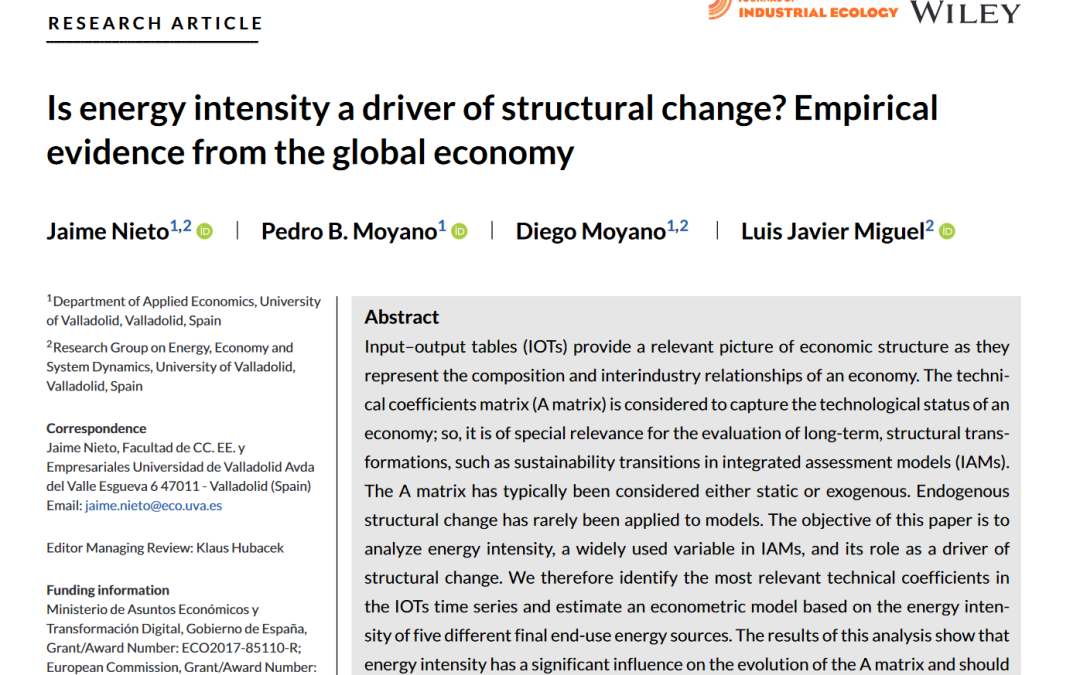José Luis Sampedro provides a satisfactory definition of structure: “a set of elements and relations that characterize, with a certain degree of permanence, a reality” (Sampedro,1961). That is, to understand the structure of an economy, it is necessary to pay attention to its different components and the multidirectional links that exist between them. In the same way, these relations must have a “certain” permanence” that would not be at odds with the notion of structural change. There is a wealth of literature on the determinants of structural change and, although this is an unresolved debate, there is little doubt that it is multidimensional: there is no single explanatory factor. Institutional, cultural, or technological elements co-evolve and cross-influence each other in any process of structural transformation.
In this new publication (open access) in the Journal of Industrial Ecology we empirically address the issue and find evidence of the influence of a society’s energy metabolism on its economic structure. For this, we take a historical series of Input-Output Tables (IOTs) on a global scale whose monetary values have been discounted the effects of price variation. The Input-Output analysis, developed by the Nobel Prize in Economics Wassily Leontief, provides a photograph of the sectoral interrelationships of an economy through its matrix of technical coefficients (Matrix A). This matrix reports on the proportion of inputs provided by other sectors that each sector needs to produce goods and services (output). For example, the shift from traditional to modern agriculture should be reflected in matrix A through an increase in the weight of industrial inputs (machinery, refined petroleum products, etc.) in the agricultural sector. Similarly, the higher the total proportion of inputs a sector need to produce its output, the lower its capacity to generate value added (wages and benefits) without increasing prices. Alternatively, a reduction in the proportion of inputs needed to produce a unit of output indicated a structure that is, in principle, more efficient and could be linked to a dematerialization process.
In this new article we qualify the historical effect of the evolution of energy intensity -measured as the ratio of final energy use by the production of each sector- from 5 different sources (electricity, gas, solids, liquids, and heat) in the evolution of Matrix A. The results show the following:
- In general, it is demonstrated that the evolution and composition by sources of energy intensity of a society has a significant effect on its economic structure.
- In most cases, a decrease in energy intensity leads to a reduction in the proportion that the value of inputs represents on the total value of production -theoretically freeing up space for an increase in their added value or for a reduction in prices.
- However, there is a significant number of relationships in the opposite direction, in which a decrease in intensity leads to an increase in the proportion of necessary inputs per unit produced.
These results have different implications. First of all, it seems clear that the intensity with which the economy demands energy inputs, depending, in turn, on the type of energy demanded, contributes significantly to explaining structural change. This highlights the need to adapt industrial policy to the needs of the energy transitions towards decarbonization. For those sectors where the relationship described in point 2 above predominates (lower intensity reduces the required inputs) energy efficiency and electrification measures should be prioritized -as electricity proved to be the most significant source in the evolution of their technical coefficients. These sectors include, among others, mining, energy refining and manufacturing sectors such as machinery production, transportation, and electrical equipment, as well as the surface and water transportation sectors. In these cases, the thermodynamic limits that exist for large increases in supply efficiency (at the device level) and the technical feasibility of electrification must always be considered, as is the case for heavy freight transportation, whether
by road or water. To overcome these frictions, consumption reduction emerges as the most advisable alternative, with special emphasis on transport (also one of the most C02 emitting sectors): urban planning to reduce the number of trips required, collective and public transportation, promotion of electric railroads; but also changes in general consumption patterns aimed at reducing the demand for goods and services.
A possible reduction in the proportion of inputs needed to produce in an economy, moreover, could have contradictory second-round effects. Thus, a more efficient economic structure -requiring fewer inputs to obtain the same level of output- could lead to two different situations: 1/ an increase in the value added, if prices remain constant; 2/ a generalized reduction in prices. In the first case, there would be an increase in disposable income and, in the second case, an increase in real income -with the same amount of income, a greater number of goods and services can be consumed. Therefore, both situations would contribute to an aggregate increase in the demand for goods and services, encouraging a rebound effect that would potentially fully or partially offset the initial effects of the efficiency improvement. Corrective mechanisms for this rebound effect would therefore be advisable. On the one hand, demand management policies aimed at reducing aggregate consumption in the economy. On the other hand, if there is an increase in value added, progressive taxation measures should be applied to help finance these policies.
Unfortunately, what has been observed at the macro level in recent years is not a decrease in the intensity with which production demands inputs, but rather the opposite. This is despite a general improvement in energy efficiency. This only underscores the importance of demand management measures, as well as the importance of having an industrial policy that is well informed about the effects that different energy sources can have on the structure of the economy.
Authors: Jaime Nieto, Pedro B. Moyano y Luis J. Miguel.
https://onlinelibrary.wiley.com/doi/10.1111/jiec.13352
References
Sampedro, J.L. (1961). Realidad económica y análisis estructural, Ed. Aguilar. Madrid.
Translation from Spanish version of this blog post: María García



